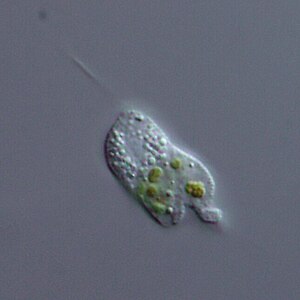Monadofilosa
| Monadofilosa | |
|---|---|

| |
| Cercomonas | |
| Scientific classification | |
| Kingdom: | Chromista |
| Phylum: | Cercozoa |
| Clade: | Filosa |
| Subphylum: | Monadofilosa Cavalier-Smith, 1997 |
| Classes | |
| |
Monadofilosa is a grouping of Cercozoa.[1] (It is sometimes considered one of three, the other two being Phytomyxa and Reticulofilosa.)[citation needed] These organisms are single-celled amoeboid protists.
Classification
Monadofilosa includes the testaceans, which are testate filose amoeboids, and the cercomonads.
It is sometimes described as Testaceafilosia and Sarcomonadea.[2]
It has also been described as Sarcomonadea (Cercomonas, Heteromita, Bodomorpha, Proleptomonas, Allantion), Thecofilosea (Cryptodifflugia, Cryothecomonas), Spongomonadea (Spongomonas, Rhipidodendron), and Imbricatea (Thaumatomonas, Thaumatomastix, Allas, Gyromitus, Euglypha, Trinema, Paulinella).[3]
- The testaceans live both in marine and freshwater habitats, and in mosses. Members include Lecythium, Pseudodifflugia, Euglypha (a euglyphid), and Paulinella chromatophora.
- Cercomonads are flagellates that glide on their posterior cilium and/or generate filopodia. Members of this group contain Cryothecomonas, Thaumatomonas, which is covered with siliceous scales, and Cercomonas, which is naked. Cercomonas contains several species that show exhibit amoeboid movement, such as the testate amoeba Cyphoderia, and the flagellate Cryothecomonas.
Monadofilosa is sometimes treated as a superclass rather than a subphylum.
Sainouron has been grouped in Monadofilosa.[4]
Phylogeny
Phylogeny based on Bass et al. 2009,[5] Howe et al. 2011[6] and Bass et al. 2016.[7]
|
Sarcomonadea (paraphyletic) |
Taxonomy
- Infraphylum Monadofilosa Cavalier-Smith 1997 stat. n. Cavalier-Smith & Oates 2012 [Eoglissa Cavalier-Smiths 2012][8]
- Family ?Katabiidae Cavalier-Smith 2012
- Order ?Pseudodimorphida
- Order Cercomonadida Poche 1913 emend. Karpov et al. 2006
- Class Helkesea Cavalier-Smith 2017
- Order Ventricleftida Cavalier-Smith 2011
- Order Helkesida Cavalier-Smith 2017 [Sainourida]
- Class Metromonadea Cavalier-Smith 2007
- Order Metromonadida Bass & Cavalier-Smith 2004 emend. Cavalier-Smith & Oates 2012
- Order Metopiida Cavalier-Smith 2003
- Clade Glissomonadida-Pansomonadida
- Order Pseudosporida Hibberd 1983 sensu Cavalier-Smith 1993
- Order Dimorphida Siemensma 1991 [Endonucleoplastiales]
- Order Glissomonadida Howe & Cavalier-Smith 2009 emend. Hess et al. 2013
- Order Pansomonadida Vickerman 2005
- Superclass Ventrifilosa Cavalier-Smith 2012
- Class Thecofilosea Cavalier-Smith 2003 emend. Cavalier-Smith 2011 [Tripylea Hertwig 1879]
- Order ?Hemimastigida Foissner, Blatterer & Foissner 1988
- Subclass Eothecia Cavalier-Smith 2012
- Family ?Botuliformidae
- Order Matazida Cavalier-Smith 2012
- Order Ebriida Poche [Ebriales Honigsberg 1964; Stereotestales]
- Order Cryomonadida Cavalier-Smith 1993 [Cryothecomonadida]
- Subclass Tectosia Cavalier-Smith 2012
- Order Tectofilosida Cavalier-Smith & Chao 2003
- Infraclass Phaeodaria Haeckel 1879 stat. n. Cavalier-Smith & Chao 2012
- Order Eodarida Cavalier-Smith 2012
- Order Opaloconchida Cavalier-Smith 2012
- Class Silicofilosea Adl et al. 2005 emend. Adl et al. 2012 [Imbricatea Cavalier-Smith 2011]
- Subclass Placoperla Cavalier-Smith 2012
- Superorder Perlatia Cavalier-Smith 2012
- Order Perlofilida Cavalier-Smith 2012
- Order Spongomonadida Hibberd 1983 emend. Karpov 1990
- Superorder Placofila Cavalier-Smith 2012
- Order Zoelucasida Cavalier-Smith 2014
- Order Rotosphaerida Rainer 1968
- Order Thaumatomonadida Shirkina 1987
- Superorder Perlatia Cavalier-Smith 2012
- Subclass Placonuda Cavalier-Smith 2012
- Order ?Discocelida Cavalier-Smith 1997
- Order ?Discomonadida Cavalier-Smith 2014
- Superorder Euglyphia Cavalier-Smith 2012
- Order Euglyphida Copeland 1956 emend. Cavalier-Smith 1997 [Euglyphina Bovee 1985]
- Superorder Nudisarca Cavalier-Smith 2012
- Order Variglissida Cavalier-Smith 2014 [Clautriaviida; Nudifilida]
- Order Marimonadida Cavalier-Smith & Bass 2011 [Auranticordida]
- Subclass Placoperla Cavalier-Smith 2012
- Class Thecofilosea Cavalier-Smith 2003 emend. Cavalier-Smith 2011 [Tripylea Hertwig 1879]
References
- ^ Cavalier-Smith T, Chao EE (October 2003). "Phylogeny and classification of phylum Cercozoa (Protozoa)". Protist. 154 (3–4): 341–58. doi:10.1078/143446103322454112. PMID 14658494.
- ^ Wylezich C, Meisterfeld R, Meisterfeld S, Schlegel M (2002). "Phylogenetic analyses of small subunit ribosomal RNA coding regions reveal a monophyletic lineage of euglyphid testate amoebae (Order Euglyphida)". J. Eukaryot. Microbiol. 49 (2): 108–18. doi:10.1111/j.1550-7408.2002.tb00352.x. PMID 12043958. S2CID 33818305.
- ^ "www.nies.go.jp". Archived from the original on 2011-07-16. Retrieved 2009-06-26.
- ^ Cavalier-Smith T, Lewis R, Chao EE, Oates B, Bass D (October 2008). "Morphology and phylogeny of Sainouron acronematica sp. n. and the ultrastructural unity of Cercozoa". Protist. 159 (4): 591–620. doi:10.1016/j.protis.2008.04.002. PMID 18583188.
- ^ Bass D, Chao EE, Nikolaev S, et al. (February 2009). "Phylogeny of Novel Naked Filose and Reticulose Cercozoa: Granofilosea cl. n. and Proteomyxidea Revised". Protist. 160 (1): 75–109. doi:10.1016/j.protis.2008.07.002. PMID 18952499.
- ^ Howe; et al. (2011), "Novel Cultured Protists Identify Deep-branching Environmental DNA Clades of Cercozoa: New Genera Tremula, Micrometopion, Minimassisteria, Nudifila, Peregrinia", Protist, 162 (2): 332–372, doi:10.1016/j.protis.2010.10.002, PMID 21295519
- ^ Bass, et al. (2016). "Coprophilic amoebae and flagellates, including Guttulinopsis, Rosculus and Helkesimastix, characterise a divergent and diverse rhizarian radiation and contribute to a large diversity of faecal-associated protists". Environmental Microbiology. 18 (5): 1604–1619. doi:10.1111/1462-2920.13235. PMID 26914587.
- ^ Cavalier-Smith, Thomas (5 September 2017). "Kingdom Chromista and its eight phyla: a new synthesis emphasising periplastid protein targeting, cytoskeletal and periplastid evolution, and ancient divergences". Protoplasma. 255 (1): 297–357. doi:10.1007/s00709-017-1147-3. PMC 5756292. PMID 28875267.
External links
Error: "Q18647895" is not a valid Wikidata entity ID.
BoilerPlate was here
- Articles with short description
- Articles with 'species' microformats
- All articles with unsourced statements
- Articles with unsourced statements from June 2009
- Commons category link is the pagename
- Taxonbars desynced from Wikidata
- Taxonbar pages requiring a Wikidata item
- Taxonbars with invalid from parameters
- Taxonbars without secondary Wikidata taxon IDs
- Filosa
- Superclasses (biology)